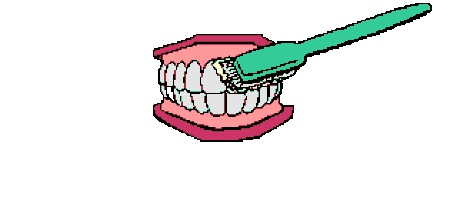Brushing Your Teeth with F
Rationale: This lesson will help children identify /f/, the phoneme represented by F. Students will learn to recognize /f/ in spoken words by learning a memorable and meaningful representation (brushing your teeth) and the letter symbol F, practice finding /f/ in words, and apply phoneme awareness with /f/ in phonetic cue reading.
Materials:
Chart with ''Fran finds flowers in the field for her father.''
Dr. Seuss's One Fish Two Fish Red Fish Blue Fish (Random House, 1960)
word cards with FIX, RAKE, FRY, HIVE, FORK
pipe cleaners
craft sticks
glue
assessment worksheet
Primary Paper
Procedures:
1. Say: Our written language is a secret code. The tricky part is learning what letters stand for - the mouth moves we make as we say words. Today we're going to work on spotting the mouth move /f/. We spell /f/ with letter F. F sounds like our toothbrush scrubbing our teeth, and looks like a toothbrush
2. Let's pretend we are brushing our teeth, /f/, /f/, /f/. [Pretend to brush your teeth] Notice where your top teeth are? (Touching lower lip). When we say /f/, we blow air between our top teeth and lower lip.
3. Let me show you how to find /f/ in the word flower. I'm going to stretch flower out in super slow motion and listen for my toothbrush. Fff-ll-ow-er. Slower: Fff-ll-ow-er. There it was! I felt my teeth touch my lip and blow air. I can hear the toothbrush sound in flower.
4. Let's try a tongue twister [on chart]. One day Fran and her dad were playing tag in the back year. They were running, laughing and having a wonderful time, when all of a sudden, Fran’s father fell over a tree stump and broke his leg. Fran went and got her mother so she could take him to the hospital. Fran’s father got a cast put on his leg, and had to come home and rest. Fran felt so bad for dad, so "Fran finds flowers in the field for her father." Let's say it three times together. Now say it again, and this time, stretch the /f/ at the beginning of the words. "Fff-ran fff-inds fff-lowers in the fff-ield fff-or her fff-ather." Try it again, and this time break it off the word: "/f/ ran /f/ inds /f/ lowers in the /f/ ield /f/ or her /f/ ather.
5. [Have students take out primary paper and pencil]. We use letter F to spell /f/. Capital F looks like a toothbrush. Let's write the lowercase letter f. Start just below the rooftop. Start to make a little c up in the air, then straighten it out all the way down to the sidewalk. Then cross it at the fence. I want to see everybody's f. After I put a star on it, I want you to make nine more just like it.
6. Call on students to answer and tell how they knew: Do you hear /f/ in work or
fun? Fan or pan? On or off? Right or left? Stiff or sore? Say: Let's see if you can spot the mouth move /f/ in some words. Brush your teeth is you hear /f/: Frank, is, funny, when, he, flies, his, flamingo, kite.
7. Before reading the book, have students construct a toothbrush out of craft sticks and pipe cleaners. Say: Let's look at this book, One Fish Two Fish Red Fish Blue Fish. This book is about funny little fish and other creatures, some are red and some are blue. Some are fat and some are thin. What other kind of funny creatures do you think are in this book? I'll read the book to you, and when you hear /f/, brush your teeth.
8. Show FIG and model how to decide if it is fig or pig: The F tells me to brush my teeth, /f/, so this word is fff-i-g, fig. You try some: FIX: fix or mix? RAKE: rake or fake? FRY: fry or dry? HIVE: hive or five? FORK: fork or pork?
9. For assessment, distribute worksheet. Students are to circle the pictures that start with /f/. Students can color their worksheet. Display in class.
Return to Horizons Index
References:
http://www.auburn.edu/academic/education/reading_genie/sightings/murrayel.html
Dr. Seuss's One Fish Two Fish Red Fish Blue Fish (Random House, 1960)
